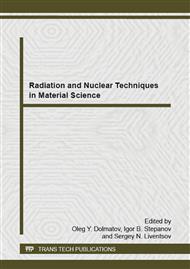p.77
p.82
p.89
p.93
p.97
p.107
p.111
p.115
p.121
Cluster Structure of Salt Solutions in Polar Dielectric Liquids
Abstract:
The aim of the study is to demonstrate that separation of solvated ions in solution of mixed salts under the action of external periodic electric field is caused by the formation of clusters consisting of solvent molecules and surrounding the ions. Such clusters have the dimensions of about 0.1 µm. The study includes the theoretical estimation of cluster dimensions and experimental determination of the external electric field frequency that gives rise to the separation of solvated ions. The results testify that placing the volume distributed electric charge of ion into dielectric liquid is accompanied by the formation of supramolecular particles. We called such particles “clusters”. The linear dimensions of clusters significantly exceed the first and the second radii of solvation (approximately 1 Angstrom) and amount to nearly 0.1 µm. At such sizes, inertial properties of clusters and their natural frequencies may allow controlling their movement by applying an external electric field to solution.
Info:
Periodical:
Pages:
97-106
Citation:
Online since:
January 2015
Authors:
Keywords:
Price:
Сopyright:
© 2015 Trans Tech Publications Ltd. All Rights Reserved
Share:
Citation:


